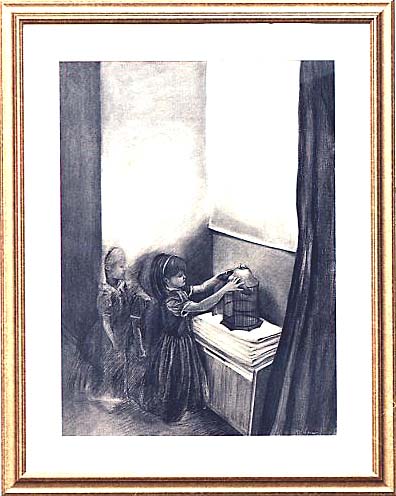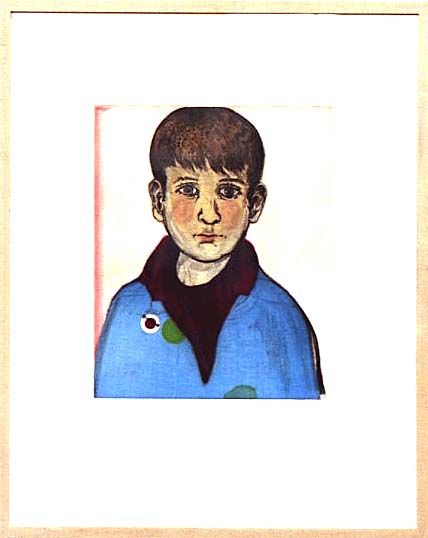State Fair Winners: Drawings, Printmaking
Kris Lowe and Todd Bridigum won top honors at the Fair in drawing and printmaking; here are their profiles.


Kris Lowe
Grand Prize, drawing
“Two Cardinals,” charcoal
Two small girls approach two caged birds—but is it two girls? There’s only one, but there are two moments in this drawing. The towering space of the alcove and the spare greys of the upper reaches of the drawing dwarf the small person who moves through the space. This is drawing showing what photography cannot: the drama of passing time.
Kris Lowe lives with her daughter Francesca, the subject of this drawing, in Burnsville. She lives in Burnsville because it’s equidistant from the three schools where she teaches drawing: MCAD, The School of Visual Arts in St. Paul, and St. Olaf College in Northfield. She remarks about this drawing: “It’s a compilation of sketches and memory. Because Francesca is 5, she doesn’t pose, she never stops moving—with the figure in motion, the drawing evolves, it takes the movement forward.”
“I do nonstop looking when I’m with my daughter, trying to really see her . . .”
Time is always a factor in Kris Lowe’s drawings. She says that “the passage of time, physically, and the growth of a child, spiritually and emotionally, is the most important aspect of this drawing. Drawing contains a process in an unmitigated way.”
Her next anticipated subject is the carrousel in Como Park.
Todd Bridigum
Grand Prize, printmaking
For “Boy in Blue,” intaglio print
“It’s a portrait,” says Todd Bridigum of his Boy in Blue, “inspired by my nephew—but it’s also a self-portrait, about my feelings about childhood, how it feels to be a kid growing up. Like when you get to be about 12, and you wake up to how things are in the world. Sometimes it can be a wondrous thing and sometimes it’s a little too much.”
Todd Bridigum teaches welding and metal fabrication at the Minneapolis Technical and Community College. He studied printmaking at Hamline under Leo Lasanski, and later did work in the studios at Highpoint Center for printmaking. He credits these people with teaching him a great deal, both about technique and about art in general. His dedication to printmaking stems in part from his experience of these features of Minnesota’s rich human landscape.
The print that Bridigum created for the State Fair this year is a remarkable example of intaglio technique. Intaglio, even in multiple colors, is seldom created with more than one plate per print. Bridigum, by contrast, used 6 plates to construct this image. He makes a plate for each color, spreading the color on the etched or mezzotinted or drypointed area with a plastic scraper; he then wipes the plate, leaving color only in the desired areas.
When he prints each plate, he’s careful with the paper-soaking, as overwetting can increase the stretch of the paper—something that will ruin the registration of a multiple-plate print. He also controls paper stretch by running the paper with the grain, never across the grain, through the press. Each sheet is dried for several days before another color can be run.
Finally, he runs the final plate—the key plate, that ties the print together. This is the black plate, and in this print it was engraved—the lines carved directly into the metal. Bridigum makes sure that this final image is strong enough to run alone, that it’s a work on its own. This final pass locks down all the previous colors.
Understandably, this kind of print isn’t meant for huge runs. An edition of 10 to 20 is what Bridigum foresees for this work. The result is a rich, deep image that is truly resonant both in its emotional force and in its physicality: an image as powerful as its content.